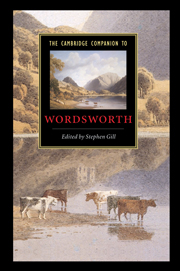Book contents
- Frontmatter
- Introduction
- 1 Wordsworth: the shape of the poetic career
- 2 Wordsworth's poetry to 1798
- 3 Poetry 1798-1807
- 4 'The noble living and the noble dead'
- 5 Wordsworth and The Recluse
- 6 Wordsworth and the meaning of taste
- 7 Wordsworth's craft
- 8 Gender and domesticity
- 9 The philosophic poet
- 10 Wordsworth and Coleridge
- 11 Wordsworth and the natural world
- 12 Politics, history, and Wordsworth's poems
- 13 Wordsworth and Romanticism
- 14 Wordsworth and America
- 15 Textual issues and a guide to further reading
- Index
- Series List
5 - Wordsworth and The Recluse
Published online by Cambridge University Press: 28 May 2006
- Frontmatter
- Introduction
- 1 Wordsworth: the shape of the poetic career
- 2 Wordsworth's poetry to 1798
- 3 Poetry 1798-1807
- 4 'The noble living and the noble dead'
- 5 Wordsworth and The Recluse
- 6 Wordsworth and the meaning of taste
- 7 Wordsworth's craft
- 8 Gender and domesticity
- 9 The philosophic poet
- 10 Wordsworth and Coleridge
- 11 Wordsworth and the natural world
- 12 Politics, history, and Wordsworth's poems
- 13 Wordsworth and Romanticism
- 14 Wordsworth and America
- 15 Textual issues and a guide to further reading
- Index
- Series List
Summary
For more than half his long life, from 1798 until he was nearly seventy, Wordsworth was writing - or thinking about writing - an immense epic poem, to be called The Recluse, which he intended to be his magnum opus. References to The Recluse occur throughout his correspondence and appear, increasingly, in modern textual, critical, and biographical writings about the poet. But since no poem with that title appears anywhere among his published works (except for a reference to it in the preface to The Excursion), many readers conclude that The Recluse does not exist, or that they, or the poet, are labouring under some kind of misconception. These suppositions are at once correct and incorrect, and both suppositions are useful.
It is true thatWordsworth never completed The Recluse. But he did finish, and publish, one part of it: The Excursion (1814), which was to be the narrative, ‘Human Life’ part of its projected three-part sequence, ‘on Man, on Nature, and on Human Life’. Book I of Part I also exists in manuscript: the popular Home at Grasmere, first published posthumously in 1888, and many times since. ‘The Tuft of Primroses’ (1808), a long manuscript poem first published in 1949, is another instalment of The Recluse, conjecturally a second book of Part I. But no Part III exists, and if it was to be ‘on Nature’, while Part I was ‘on Man’, remains a mystery, not least because The Recluse’s three thematic terms interweave so closely throughout its extant parts – as indeed they do throughout Wordsworth’s entire oeuvre.
- Type
- Chapter
- Information
- The Cambridge Companion to Wordsworth , pp. 70 - 89Publisher: Cambridge University PressPrint publication year: 2003
- 2
- Cited by



